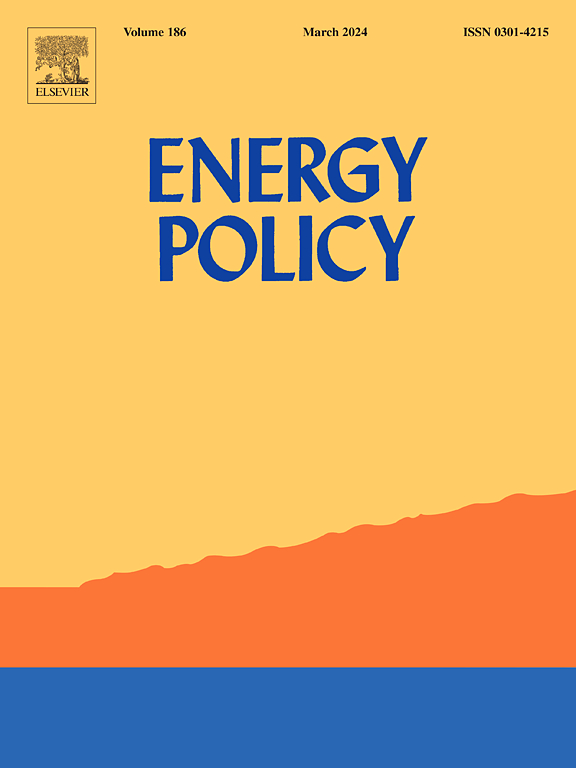Efficiency only? An analysis of avoid, shift and improve strategies in EU member states’ long-term mitigation policy
IF 9.2
2区 经济学
Q1 ECONOMICS
引用次数: 0
Abstract
Despite ambitious EU targets, national emission trajectories reported by member states continue to fall short of achieving the necessary reductions. This implementation gap raises the question of what mitigation strategies and instruments member states rely on to meet internationally binding climate targets. To explore this, we scrutinise 1584 implemented, adopted, or planned mitigation policies across the sectors of agriculture, transport, energy consumption, and industry using qualitative content analyses. Our findings reveal substantial discrepancies in the distribution of mitigation strategies. Efficiency improvements dominate EU mitigation efforts, comprising 54 % of proposed measures. In contrast, policies promoting shifts to low-carbon alternatives represent only 14 %, while those avoiding energy or service demand make up just 2 %. Even when considering broader policy mixes that include elements of shifting and reducing final demand, these strategies remain under-represented across all sectors, particularly in industry and agriculture. The remaining share of reported mitigation policies, accounting for 21 %, focus on altering broader regulatory frameworks and incentive structures, underscoring their critical role in EU member states' mitigation efforts. Additionally, we find member states to rely predominantly on economic and regulatory policy instruments, with substantial variation across mitigation strategies and sectors. Our findings carry important policy implications, unveiling EU’s reliance on efficiency-centred approaches to achieve climate targets. Given the implementation gap and the untapped potential of demand-side measures, diversifying mitigation strategies could enhance the EU’s ability to meet legally binding climate targets.
效率只有?欧盟成员国长期缓解政策中的规避、转移和改进策略分析
尽管欧盟设定了雄心勃勃的目标,但成员国报告的国家排放轨迹仍未能实现必要的减排。这一执行差距提出了一个问题,即成员国依靠哪些缓解战略和文书来实现具有国际约束力的气候目标。为了探讨这一点,我们使用定性内容分析,仔细审查了农业、交通、能源消耗和工业部门实施、采用或计划的1584项缓解政策。我们的研究结果揭示了缓解策略分布的巨大差异。提高效率是欧盟缓解措施的主要内容,占拟议措施的54%。相比之下,促进向低碳替代品转变的政策仅占14%,而避免能源或服务需求的政策仅占2%。即使考虑到包括转移和减少最终需求的因素在内的更广泛的政策组合,这些战略在所有部门,特别是在工业和农业部门的代表性仍然不足。所报告的缓解政策的其余份额(占21%)侧重于改变更广泛的监管框架和激励结构,强调了它们在欧盟成员国缓解努力中的关键作用。此外,我们发现成员国主要依赖经济和监管政策工具,缓解战略和部门之间存在很大差异。我们的研究结果具有重要的政策意义,揭示了欧盟依赖以效率为中心的方法来实现气候目标。考虑到执行差距和需求侧措施尚未开发的潜力,多样化的缓解战略可以增强欧盟实现具有法律约束力的气候目标的能力。
本文章由计算机程序翻译,如有差异,请以英文原文为准。
求助全文
约1分钟内获得全文
求助全文
来源期刊

Energy Policy
管理科学-环境科学
CiteScore
17.30
自引率
5.60%
发文量
540
审稿时长
7.9 months
期刊介绍:
Energy policy is the manner in which a given entity (often governmental) has decided to address issues of energy development including energy conversion, distribution and use as well as reduction of greenhouse gas emissions in order to contribute to climate change mitigation. The attributes of energy policy may include legislation, international treaties, incentives to investment, guidelines for energy conservation, taxation and other public policy techniques.
Energy policy is closely related to climate change policy because totalled worldwide the energy sector emits more greenhouse gas than other sectors.
 求助内容:
求助内容: 应助结果提醒方式:
应助结果提醒方式:


